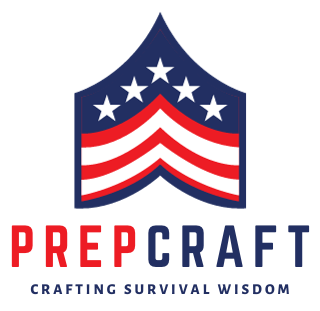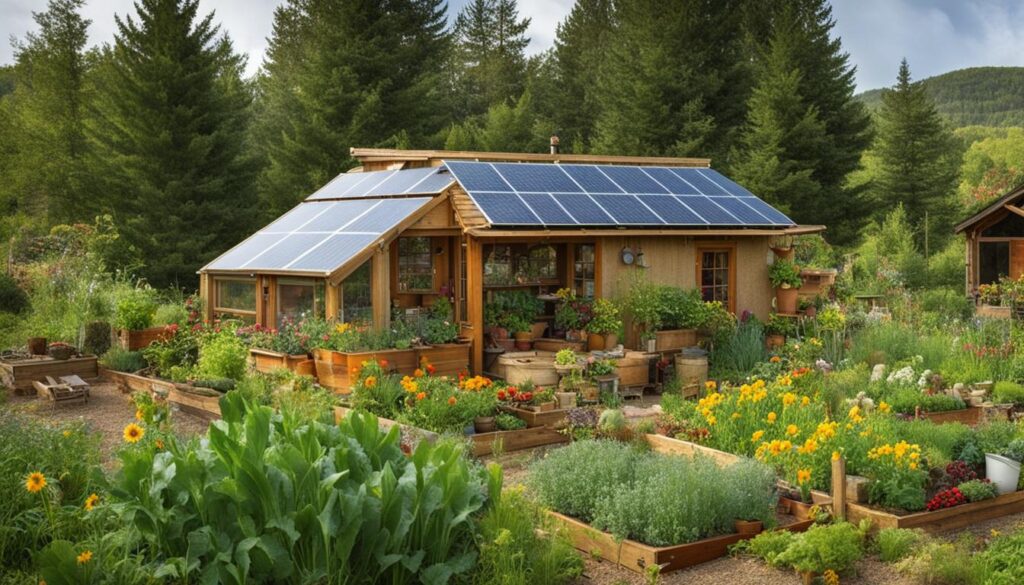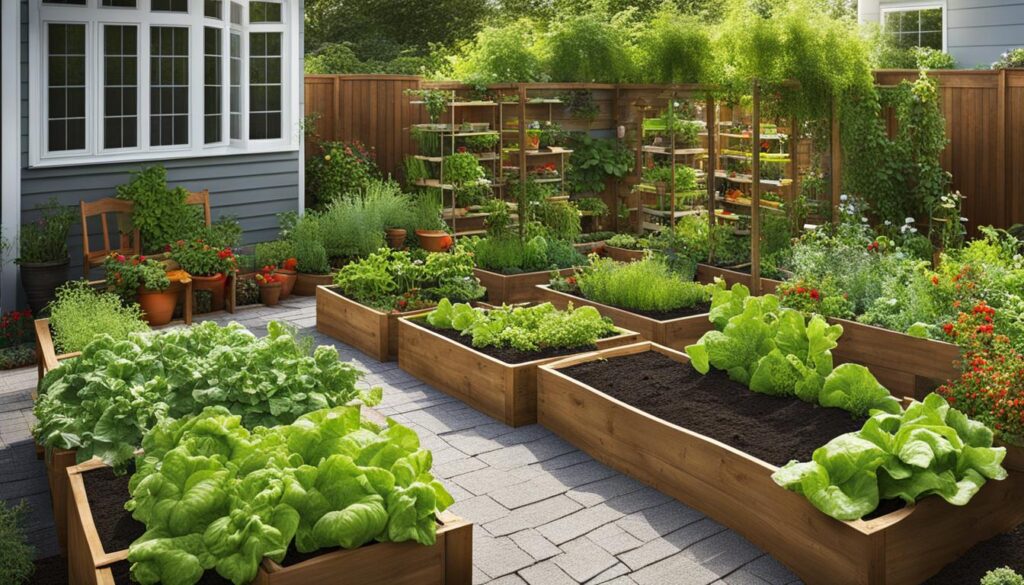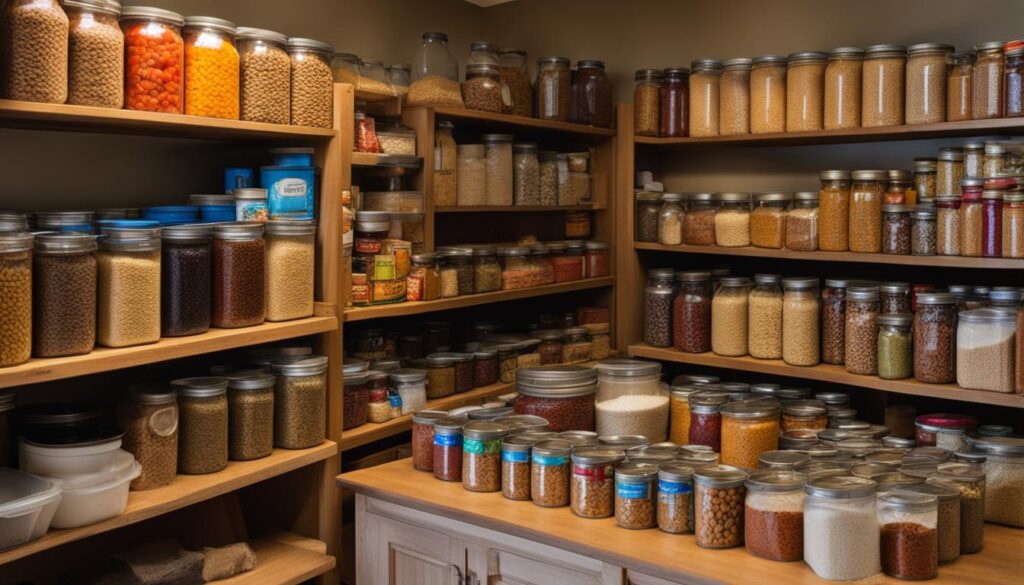
When it comes to emergency preparedness, one of the most crucial aspects is having a well-stocked emergency food supply. In times of crisis, such as natural disasters or economic collapse, having access to food can make all the difference in ensuring the safety and well-being of your family. That’s why building a prepper’s pantry and stocking it with essential food items is an important step in your emergency preparedness plan.
Long-term food storage is not just about stockpiling canned goods. It requires careful consideration of various factors such as shelf life, storage ease, nutritional value, and dietary restrictions. As a prepper, it’s essential to select foods that are both shelf-stable and non-perishable, ensuring they can be easily stored, prepared, and consumed during an emergency.
Emergency food kits and prepper pantry staples should include a variety of food groups to provide a well-rounded and balanced diet. This includes grains, beans and legumes, fats, and meats and other proteins. By having a diverse selection of these essential pantry items, you can ensure that you and your family have the necessary nutrients to sustain yourselves during times of crisis.
Key Takeaways:
- Emergency food storage is crucial for ensuring the safety and well-being of your family during unexpected crises.
- Building a prepper’s pantry involves selecting foods with a long shelf life, easy storage, and easy preparation.
- Include a variety of food groups, such as grains, beans and legumes, fats, and meats and other proteins.
- Proper storage and understanding shelf life are essential for maintaining an effective emergency food supply.
- By organizing your prepper’s pantry, you can easily manage your food inventory and ensure a balanced diet during emergencies.
Building an Emergency Food Storage
Building an emergency food storage is a crucial step in preparing for unexpected crises. When selecting food items for your emergency supply, it’s important to consider several criteria: a long shelf life, easy storage, easy preparation, nutritional value, calorie density, and dietary restrictions. By carefully choosing products that meet these criteria, you can ensure that your family’s nutritional needs are met during an emergency.
First and foremost, focus on food items with a long shelf life. Look for products that can last at least a year, allowing you to stock up well in advance. Durable packaging is also essential to protect the food from damage and preserve its freshness for an extended period.
Additionally, prioritize food items that are easy to store and require minimal preparation. During an emergency, utility access may be limited, so having food that can be eaten as-is or easily prepared with minimal utilities is essential. Consider options like canned goods, freeze-dried meals, or dehydrated foods that only require water or minimal cooking to prepare.
Furthermore, it’s important to select food items that are not only easy to prepare but also nutritionally dense. Look for items that provide a good balance of essential nutrients to support your family’s health during challenging times. Consider including a variety of fruits, vegetables, whole grains, and protein sources like canned meat or legumes.
Calorie density is another important factor to consider when building your emergency food storage. Aim for food items that provide a high number of calories per serving, as these can sustain you and your family during times when food may be scarce. Include energy-dense foods like nuts, nut butter, granola bars, and high-calorie meal replacements.
Lastly, don’t forget to take into account any dietary restrictions that you or your family members may have. Consider allergies, religious dietary requirements, or specific cultural preferences when selecting food items for your emergency supply.
Building an emergency food storage that meets these criteria will ensure that you and your loved ones are prepared for any unexpected situation. By taking the time to carefully select food items that have a long shelf life, are easy to store and prepare, are nutritionally dense, calorie-dense, and suitable for dietary restrictions, you can have peace of mind knowing that you have a reliable source of sustenance in times of need.
Whether it’s a natural disaster or any other emergency, having an emergency food storage can provide a sense of security and ensure the well-being of your family. In the next section, we will discuss what specific food items should be included in your prepper’s pantry to create a well-rounded emergency food supply.
What Foods to Include in Your Prepper’s Pantry
When stocking your prepper’s pantry, it’s important to include a variety of food items that will provide the necessary nutrients and sustenance during an emergency. Here’s a list of essential food categories to consider:
Grains
Grains are a staple in every prepper’s pantry due to their versatility, long shelf life, and nutritional value. Some must-have grains include:
- Rice
- Wheat berries
- Oats
Beans and Legumes
Beans and legumes are excellent sources of protein and fiber, making them crucial components of a well-rounded emergency food supply. Stock up on the following varieties:
- Pinto beans
- Black beans
- Lentils
Fats
Fats are essential for cooking, nutrition, and satiety. Include the following fats in your prepper’s pantry:
- Lard
- Peanut butter
- Vegetable oil
Meats and Other Proteins
Protein is vital for maintaining energy levels and muscle function. Consider stocking up on the following meats and protein sources:
- Canned salmon
- Sardines
- Canned chicken
Remember, this is just a starting point for building your prepper’s pantry. Customize your food list based on your family’s preferences, dietary restrictions, and specific nutritional needs.
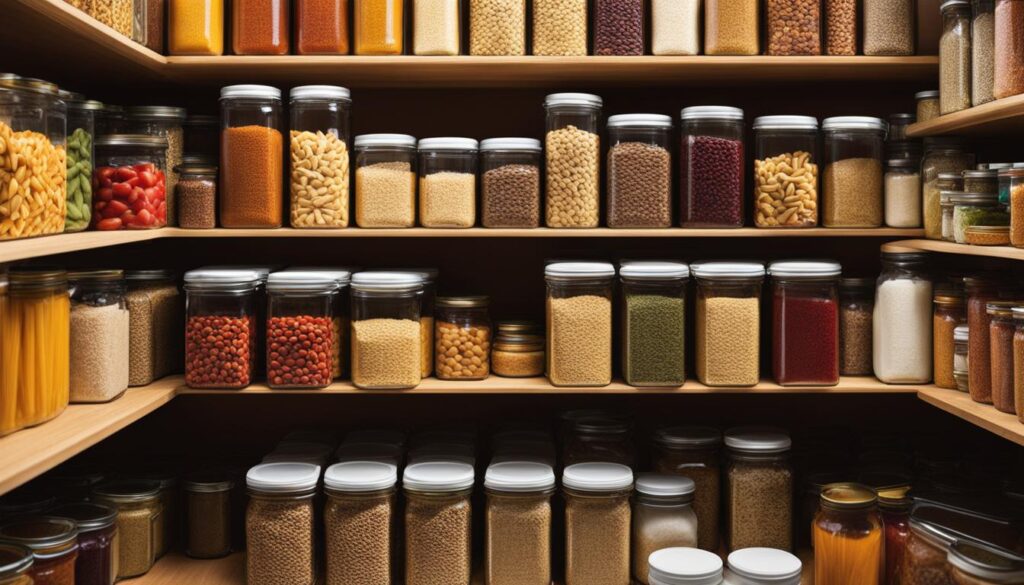
Having a variety of these pantry staples will ensure a diverse and balanced emergency food supply that can sustain your family during a crisis.
Importance of Storage and Shelf Life
Proper storage and understanding the shelf life of food items are crucial for maintaining an effective emergency food supply. When it comes to building an emergency pantry, it’s essential to select shelf-stable and non-perishable foods that can be safely stored at room temperature for an extended period. These foods can provide sustenance during times of crisis when access to fresh produce and perishable items may be limited or unavailable.
Shelf-stable foods, such as canned goods, country hams, rice, pasta, flour, sugar, and spices, have undergone specific processing methods that allow them to remain safe and edible for a considerable amount of time. These foods are often packaged in a way that minimizes exposure to factors that can accelerate spoilage, such as light, moisture, pests, and oxygen.
However, it’s important to note that not all canned goods are shelf-stable. Some canned goods, particularly those with low acidity levels, may have a shorter shelf life and require refrigeration. It’s crucial to check the expiration dates and storage instructions before purchasing and consuming these canned goods to ensure their safety and quality.
Factors Affecting Shelf Life
Several factors can affect the shelf life of stored food items. It’s essential to be aware of these factors and take appropriate measures to minimize their impact:
- Heat: Exposure to high temperatures can accelerate the deterioration of food and reduce its shelf life. It’s recommended to store emergency food supplies in a cool, dry place away from heat sources such as stoves, ovens, or direct sunlight.
- Light: Light can degrade the quality of certain food items, particularly those that are exposed to direct sunlight for extended periods. It’s advisable to store food in opaque or light-blocking containers or in a pantry with minimal exposure to light.
- Moisture: Excessive moisture can promote the growth of mold, bacteria, and other microorganisms, leading to food spoilage. It’s crucial to store food items in moisture-resistant packaging and in areas with low humidity to ensure their longevity.
- Pests: Insects, rodents, and other pests can infiltrate food storage areas and contaminate stored food items. Properly sealed containers and regular pest control measures can help protect the integrity of your emergency food supply.
- Oxygen: Exposure to oxygen can cause oxidation and lead to the deterioration of certain food items, resulting in changes in flavor, texture, and nutrient content. Vacuum-sealed packaging or the use of oxygen absorbers can help minimize the presence of oxygen and extend the shelf life of stored food.
By understanding and addressing these factors, you can optimize the storage conditions of your emergency food supply and ensure that your stored food items remain safe, palatable, and nutritious for as long as possible.
Checking Expiration Dates and Signs of Spoilage
While many shelf-stable foods can surpass their “best by” dates without significant issues, it’s crucial to exercise caution and regularly check for signs of spoilage or can damage before consuming.
Here are some guidelines for checking the quality and safety of stored food items:
- Inspect the packaging for dents, bulges, leaks, or other signs of damage. Discard any damaged cans or containers as they may indicate compromised product integrity.
- Check for any unusual odors, off-flavors, or discoloration. These can be indicators of spoilage.
- Pay attention to the texture and consistency of the food. Changes in texture, such as mushiness or excessive hardness, can suggest spoilage or loss of quality.
- If in doubt, it’s best to err on the side of caution and discard any food items that show signs of spoilage or have exceeded their expiration dates.
By regularly monitoring the condition of your emergency food supply and adhering to proper storage practices, you can ensure that your stored food items remain safe, reliable, and nourishing during times of need.
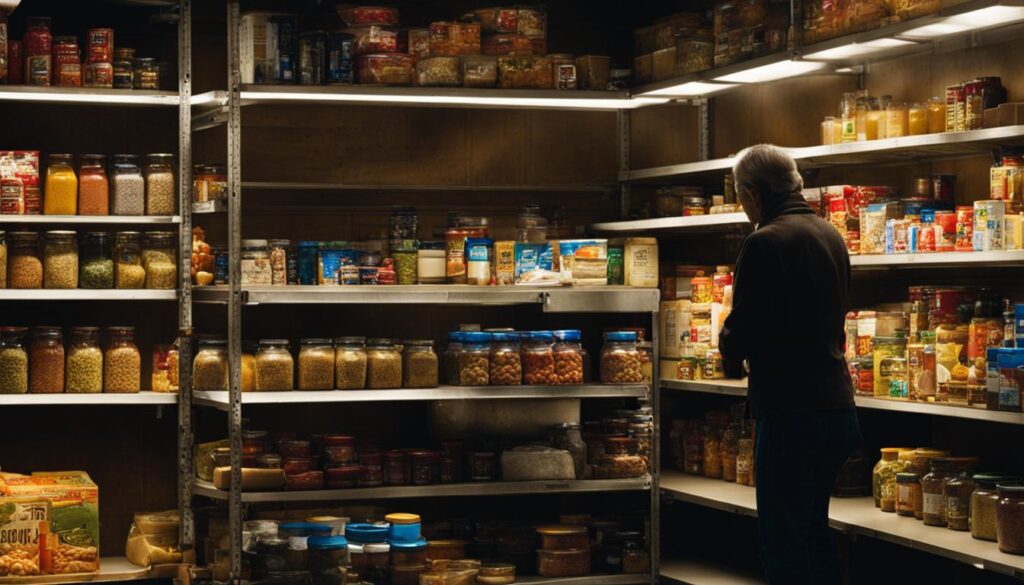
Prepper Pantry Organization
Organizing your prepper’s pantry is vital for easy access and efficient rotation of food items. Having a well-organized pantry will not only save you time but also ensure that your emergency food supply remains fresh and readily available when you need it most.
I recommend dedicating a separate storage space solely to your emergency food supply. This separate area will help prevent cross-contamination with other household items and allow for better inventory management. Find a cool and dry area in your home, such as a basement or pantry, to store your emergency food stash. Ensure that there are proper shelves or racks to prevent food from being stored directly on the floor, minimizing the risk of spoilage or pests.
Storage containers are essential for maintaining the freshness and longevity of your emergency food items. Consider using airtight containers that provide protection against moisture, oxygen, and pests. Many preppers use mylar bags with oxygen absorbers for sealing dry food items. These bags help extend the shelf life of products like rice, beans, and pasta, keeping them fresh for longer periods.
Another crucial aspect of pantry organization is labeling. Label each container with the contents and the expiration date, making it easier to track and rotate your food inventory. This practice ensures that you consume the oldest items first, reducing waste and maintaining a well-stocked emergency food supply.
In addition to focusing on storage and organization, it’s important to consider the nutritional value of the foods you stock in your prepper’s pantry. Prioritize selecting a variety of nutrient-dense options that meet your family’s dietary needs. If necessary, include supplements to ensure a balanced diet during an emergency.
By establishing a well-organized prepper’s pantry with separate storage space, proper containers, clear labeling, and nutritious food choices, you can easily manage your food inventory and have peace of mind during times of crisis.
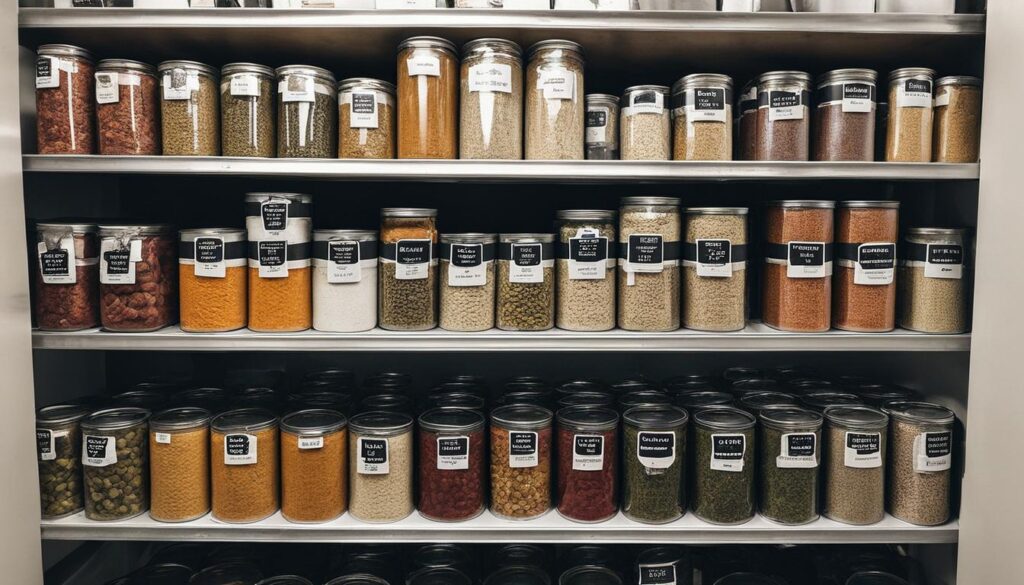
A well-organized prepper’s pantry creates an efficient and accessible food storage system
Building a Long-Term Food Storage
If you’re looking to build a long-term food storage, it’s important to consider buying food items in bulk. Buying in bulk saves time, money, and space when it comes to shopping and food storage. Additionally, learning the art of canning and dehydrating can be valuable skills for preserving food for an extended period.
Canning allows you to store various fruits, vegetables, and meats in jars, while dehydrating involves removing moisture from food items to extend their shelf life. Another option for long-term food storage is investing in freeze-dried foods, which have a shelf life of 25 years or more and retain their nutritional value. These methods provide a sustainable way to ensure a long-term food supply for your emergency preparedness.
By buying in bulk and adopting preservation techniques like canning, dehydrating, and freeze-drying, you can create a long-term food storage that is both cost-effective and reliable. Let’s take a closer look at each method:
Canning
Canning is a popular method of food preservation that involves placing food in jars and sealing them to create a vacuum seal. This process removes oxygen from the jars, preventing the growth of bacteria, yeasts, and molds. Canned foods have a long shelf life and can retain their quality and nutritional value for several years. This makes them an excellent option for long-term food storage.
Dehydrating
Dehydrating is a process of removing moisture from food items to inhibit the growth of microorganisms and enzymes that cause spoilage. By reducing the moisture content, dehydrated foods become lightweight, compact, and have an extended shelf life. Dehydrated fruits, vegetables, meats, and herbs can be easily rehydrated and used in a variety of recipes, making them a versatile addition to your long-term food storage.
Freeze-dried Foods
Freeze-drying is a method of food preservation that involves freezing the food and then removing the water content through sublimation. This process preserves the food’s taste, texture, and nutritional value while extending its shelf life. Freeze-dried foods have a long storage life of 25 years or more and are lightweight, making them ideal for emergency situations or outdoor activities. Simply add water to rehydrate the food, and you’ll have a delicious meal ready to enjoy.
By incorporating these preservation methods into your long-term food storage strategy, you can ensure that your emergency supply remains viable and nutritious for an extended period. Additionally, it’s essential to store your food in cool, dry areas away from direct sunlight and fluctuating temperatures to maximize its shelf life.
Investing time and effort into building a long-term food storage will provide you with peace of mind knowing that you and your loved ones are prepared for any unexpected events. Whether you choose to buy in bulk, can and dehydrate your own food, or invest in freeze-dried options, having a well-stocked long-term food supply is a crucial step towards ensuring your family’s safety and security.
Conclusion
Building a well-stocked emergency food storage, also known as a prepper’s pantry, is crucial for the safety and well-being of your family during unexpected crises. By considering factors such as shelf life, storage ease, nutritional value, and dietary restrictions, you can create a tailored and diverse food supply that meets your family’s needs. It’s important to prioritize proper organization, storage, and understanding of shelf life to maintain an effective emergency food supply.
Long-term food storage options like buying in bulk, canning and dehydrating, and investing in freeze-dried foods offer sustainable solutions for extended preparedness. Buying in bulk saves time, money, and space, while canning and dehydrating allow you to preserve a variety of foods for an extended period. Freeze-dried foods have a long shelf life and retain their nutritional value, providing a convenient and reliable option for emergency preparedness.
With a well-prepared prepper’s pantry, you can have peace of mind knowing that your family’s safety and well-being are prioritized during emergencies. Having a diverse and well-stocked food supply ensures that you have the necessary resources to sustain your family during unexpected situations. Building an emergency food storage is an investment in preparedness, providing the foundation for your family’s resilience and protection.
FAQ
Why is emergency food storage important?
Emergency food storage is important because it ensures the safety and well-being of your family during unexpected crises. It provides a reliable food supply during natural disasters, economic collapses, or any other emergency situation.
What factors should I consider when building an emergency food storage?
When building an emergency food storage, consider the following factors: long shelf life, easy storage, easy preparation, nutritional value, calorie density, and dietary restrictions. These criteria will help you select the right food items for your pantry.
What foods should I include in my prepper’s pantry?
Include a variety of food items in your prepper’s pantry, such as grains (rice, wheat berries, oats), beans and legumes (pinto beans, black beans, lentils), fats (lard, peanut butter, vegetable oil), and meats and other proteins (canned salmon, sardines, canned chicken).
How important is storage and shelf life for emergency food storage?
Proper storage and understanding of shelf life are crucial for maintaining an effective emergency food supply. Shelf-stable and non-perishable foods should be stored correctly to minimize factors that can affect shelf life, such as heat, light, moisture, pests, and oxygen.
How should I organize my prepper’s pantry?
To organize your prepper’s pantry, have a separate storage space dedicated to your emergency food supply. Utilize proper shelving, storage containers with oxygen absorbers, mylar bags, and labels to maintain freshness and track expiration dates.
How can I build a long-term food storage?
Building a long-term food storage involves buying food items in bulk, learning the art of canning and dehydrating, and investing in freeze-dried foods. These methods provide sustainable solutions for extended preparedness.
What is the conclusion about emergency food storage?
Emergency food storage, also known as a prepper’s pantry, is essential for ensuring the safety and well-being of your family during unexpected crises. By considering various factors, such as shelf life, storage ease, and nutritional value, you can create a tailored and diverse food supply. Proper organization, storage, and understanding of shelf life are crucial. By building a well-prepared prepper’s pantry, you can have peace of mind knowing that your family’s safety is prioritized during emergencies.
